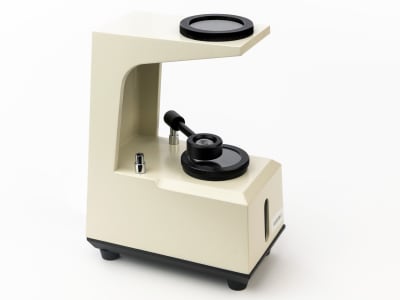The Desktop Polariscope
Overview:
A polariscope is one of a series of tools that helps with gemstone and mineral identification. It is one of the first items a student gemologist will find in their kit, and it is something that forms a critical element of the diagnostic process as the identity of a gemstone is sought. It is used in conjunction with other gemological tools to narrow the range of possible identifications. To many experienced gemologists, the polariscope is the first instrument they reach for, because what it informs them will reinforce subsequent findings on other instruments.
What is a Desktop Polariscope?
The primary purpose of a polariscope is the determination of optic character. Gemstones (and minerals) commonly exhibit different structural forms that result from their original pattern of crystal growth which are dictated by their atomic makeup. This growth pattern will influence the passage of light through a translucent and transparent gemstone. Each of these structures responds differently when viewed through a polariscope. This difference is referred to as the optic character of a gem and is one of a series of identifying features that are sought out in the journey to discover what the material is. Some gems may be singly refractive, doubly refractive or as is often the case with translucent materials, an aggregate of numerous microscopically small crystals.
A desktop polariscope is one of several items in a gemologist’s inventory that can be ‘upsized to suit someone who spends most of their time working at a fixed location. Some will even include a lighting source that will provide the light necessary to use a refractometer, which is another vital piece of equipment.
What is The Science Behind The Polariscope?
A polariscope contains two polarizing filters. The topmost is called an analyzer, and the lower part is a polarizer. In some of the portable folding polariscopes, the analyzer is fixed in the ‘crossed polarizer’ position where light will not pass from beneath the polarizer and up through the analyzer because they will cancel each other out by being set at 90 degrees to one another. This essentially means that looking through the polariscope when it is sitting over a light source, typically a flat lamp, no light will shine through, so it will appear dark. The analyzer on larger models, particularly desktop models, may be rotated to the left or right. The polarizer, or lower filter, is usually stationary.
If the analyzer (top filter) is aligned properly with the polarizer (bottom filter), it can fully block or permit the passage of light. When both filters are in the dark position (no light visible), it is referred to as crossed polars. When rotated 360°, the view through the filters will go light and dark two times. Rotating the analyzer 180° brings it back to its original dark or light position.
How to Use Your Polariscope
Step one: Switch the unit on and confirm that the polarizer and analyzer are in the crossed position: this is when the view through the analyzer is dark. This occurs by looking down through the analyzer to view the light source. Turn the analyzer (top filter) left and right. You will notice that the light becomes brighter or darker, depending on the initial position of the filters. Next, Turn the analyzer to the dark position (crossed polars).
Step two: Take your sample (gemstone or mineral), clean it with a cloth, and place it in the gem stage. Larger crystals may be more easily adjusted if they are placed on the clear glass gem stage which sits atop the polarizer. The stage will rotate without moving the polarizer. Remember that many gem materials will have a greater hardness than glass and you do not want to scratch any of the working surfaces of your polariscope. Additionally, scratches will reflect light randomly and once there are too many scratches, they will affect the results when examining smaller gems.
Step three: With your stone in place, rotate the gem stage 360° and observe the response. There are four possibilities.
1) The sample appears light through the entire rotation. It is an aggregate (A common abbreviation seen in gemological tables will be “AGG”).
2) The sample appears dark throughout the entire rotation. It is singly refractive (Commonly abbreviated to “SR”) or amorphous (such as some glass) or it is doubly refractive, and the stone is oriented along its optic axis. Change the orientation of the stone and repeat to confirm accurate results.
3) The sample blinks light and dark four times in a 360-degree rotation with each change happening 90 degrees apart. The sample may be doubly refractive (DR) or single refractive (SR) with anomalous double refraction (ADR).
4) The sample may exhibit irregular blinking that appears as snake-like bands or crosshatching. The stone is probably SR with anomalous double refraction (ADR) but may be doubly refractive. It may also be DR but displaying a twinned growth pattern. Glass, plastic, amber, garnets and synthetic spinel all commonly exhibit ADR and identification must be confirmed by other tests.
Responses 1 and 2 require no further tests. Responses 3 and 4 require a confirmation test to determine the true optic character of the sample.
How to Conduct a Polariscope Confirmation Test
Step one: Make sure the polariscope is in the dark position. If you have removed the gem stage, place it back in the polariscope frame.
Step two: Turn the gem stage until the stone appears to be at its lightest point. Be sure the filters remain in the dark position.
Step three: Quickly rotate the analyzer to the light position. This is the top filter, so the gem stage remains stationary. Observe the lightest area of the stone and see if there is any change. There are two possibilities:
1) The sample looks noticeably lighter, for it is singly refractive (SR) or amorphous, but showing Anomalous Double Refraction.
2) The sample looks the same or slightly darker, for it is doubly refractive (DR)
Advanced Use of The Desktop Polariscope
For those who have already mastered the techniques covered above, this section is for you. While the polariscope is limited in the tests it can perform, there are certain cases where it is extremely helpful, particularly for transparent rough stones, cabochons and beads.
Resolving the Optic Figure:
When resolving the optic figure the stone must be:
-Doubly refractive
-Transparent or nearly transparent
-Single crystal (not an aggregate)
-Of a size to fit in your instrument
1. Begin the test with the polariscope in the dark
position, also known as crossed filters.
2. Hold the stone in your fingers between the crossed
polars, then start rotating the stone in all directions to look for
rainbow hues (interference colors) on the surface of the stone that
will show you the optic axis. The optic axis follows an invisible,
straight line through the stone.
3. Look for the figure using the follow-the-brush
technique. Find the blinking extinction pattern. Tilt the stone to
look down the narrow end of the dark extinction brush. NOTE: For many
biaxial stones, this is the only way to find the optic axis. In some
stones, it is extremely difficult to find and sometimes not possible.
4. If you do not see interference colors or a dark extinction brush:
-Touch the optic figure sphere to all parts of the stone while you turn it. This might help you find an optic figure, even if you did not see a sign of an optic axis direction earlier.
-Place a drop of water on the optic figure sphere or put the stone in
an immersion cell filled with water. Submersing a gem in liquid
reduces surface reflection and internal refraction.
5. Once you find the interference colors, place the optic figure sphere on the heaviest concentration of intense colors. NOTE: Once you find interference colors in one direction you may try turning the stone 180°, then look for them in the opposite direction to see a clearer optic figure.
How to Maintain a Polariscope
When not using your desktop Polariscope a few simple steps will help to prolong its life.
- Unplug the unit when not in use.
- Do not touch the lenses. Clean with a damp (water) lint-free cloth.
- Use the cover shown to protect the unit from dust.
- Store in a cool, dry place.
- To date, they are still made with old-school filament bulbs (because we do not yet have LEDs that emit a full spectrum of white light), and these do not withstand rough handling the way modern LED-based lighting does.

